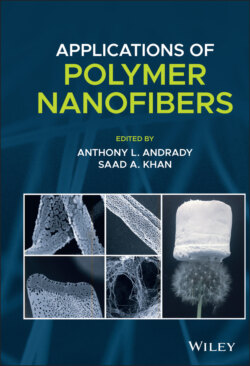Читать книгу Applications of Polymer Nanofibers - Группа авторов - Страница 31
1.7.3 Alternative Fiber Production Methods
ОглавлениеAlternative methods to nanofiber production have also been considered including solution blowing and centrifugal spinning and are compared to electrospinning methods in Table 1.3. In solution blowing, compressed air drives fiber formation. The most common setup is a concentric nozzle system with the polymer solution in the inner nozzle and a high‐pressure gas is delivered through the outer nozzles. As the polymer solution exits the nozzle, the gas shears the solutions and the solvent evaporates. The high shear forces perturb the liquid jet to a bending instability as it forms a solid nanofiber. Therefore, similar to electrospinning, the resulting fibers are affected by the bending instability, stretching, and evaporation rate of the solvent. Analogous to electrospinning, the polymer solution properties (concentration, viscosity, molecular weight, surface tension, and vapor pressure) and ambient conditions (temperature, humidity, and pressure) also affect fiber formation. The process parameters that affect the fibers are flow rate, gas flow pressure, nozzle‐to‐collector distance, and the nozzle geometry. Randomly oriented fiber with diameters between 40 nm and several μm have been achieved, comparable to electrospinning. The production rate is ~fourfold higher than electrospinning (Stojanovska et al. 2016).
Centrifugal spinning is an alternative approach with high mass production rates. Centrifugal forces initiate jet formation as in cotton‐candy production. A polymer solution or melt is fed into a rotating chamber with multiple orifices. As the chamber rotates, centrifugal forces the polymer solution/melt out of the orifices. When the centrifugal forces exceed the surface tension and viscous forces, a liquid jet is initiated. The jet elongates along a curved trajectory and the solution evaporates until the jet reaches the collector. Alternatively, a nozzle‐less system can be used, in which the liquid polymer spreads on a disk. Rayleigh–Taylor instability causes fingering and jet initiation. After jet initiation, the necking, whipping, and jet trajectories are comparable for both setups. The critical angular velocities and jet velocities for both system have been recently reviewed (Zhang and Lu 2014). Similar to electrospinning, fiber formation is primarily affected by solution properties (viscoelasticity, surface tension, and vapor pressure), setup characteristics (orifice radius) as well as process parameters (angular velocity, orifice‐to‐collector distance). The polymer properties (surface tension, molecular weight, and viscoelasticity) must suppress jet breakup to prevent the formation of droplets or breaded fibers. Using centrifugal spinning, fibers 25 nm to several μm have been achieved. Typically, fibers are uniaxially aligned. Production rates of ~50 g/h or ~100‐fold higher than electrospinning have been reported (Stojanovska et al. 2016).
Table 1.3 Comparison of fiber production methods.
| Method | Fiber size | Scale | Production rate (g/h) |
|---|---|---|---|
| Needle electrospinning | 40 nm–2 μm | Bench | 0.3 |
| Melt electrospinning | 800 nm–500 μm | Bench | 300 |
| Needleless electrospinning | 40 nm–2 μm | Industrial | 100 |
| Solution blowing | 40 nm–several μm | Bench | 1.2 |
| Centrifugal spinning | 25 nm–several μm | Bench | 50 |
In closing, electrospinning is a widely used technique for producing nonwoven nanofibers on a laboratory scale. Significant effort has been spent on understanding how process parameters, e.g. flow rate, applied voltage, tip‐to‐collector distance, affect the final fiber size using theoretical and experimental approaches. However, the experimental data is conflicting and the changes in fiber diameter relatively minor. The solution properties play a significant role in the ability to produce uniform fibers. The polymer concentration and elastic properties generally dictate electrospinnability. Factors in the electrospinning setup, e.g. auxiliary electrodes, collector geometry, provide some tunability in terms of nanoparticle size and nanofiber patterning. Ability to make hierarchical fiber structures and complex cross sections have advanced significantly and provide opportunities in advanced functional properties. Production of nanofibers on a larger scale is a growing area of interest.
